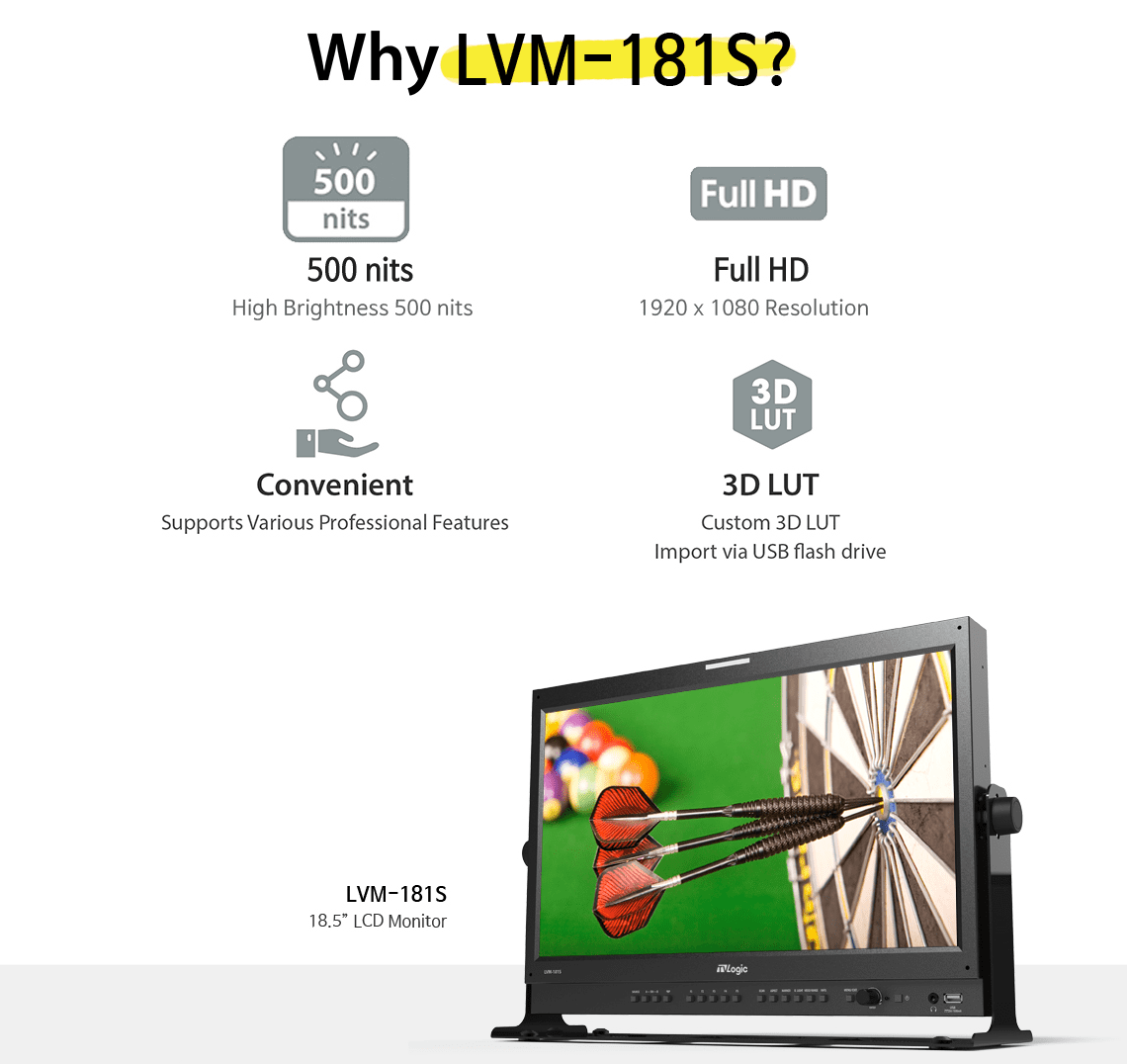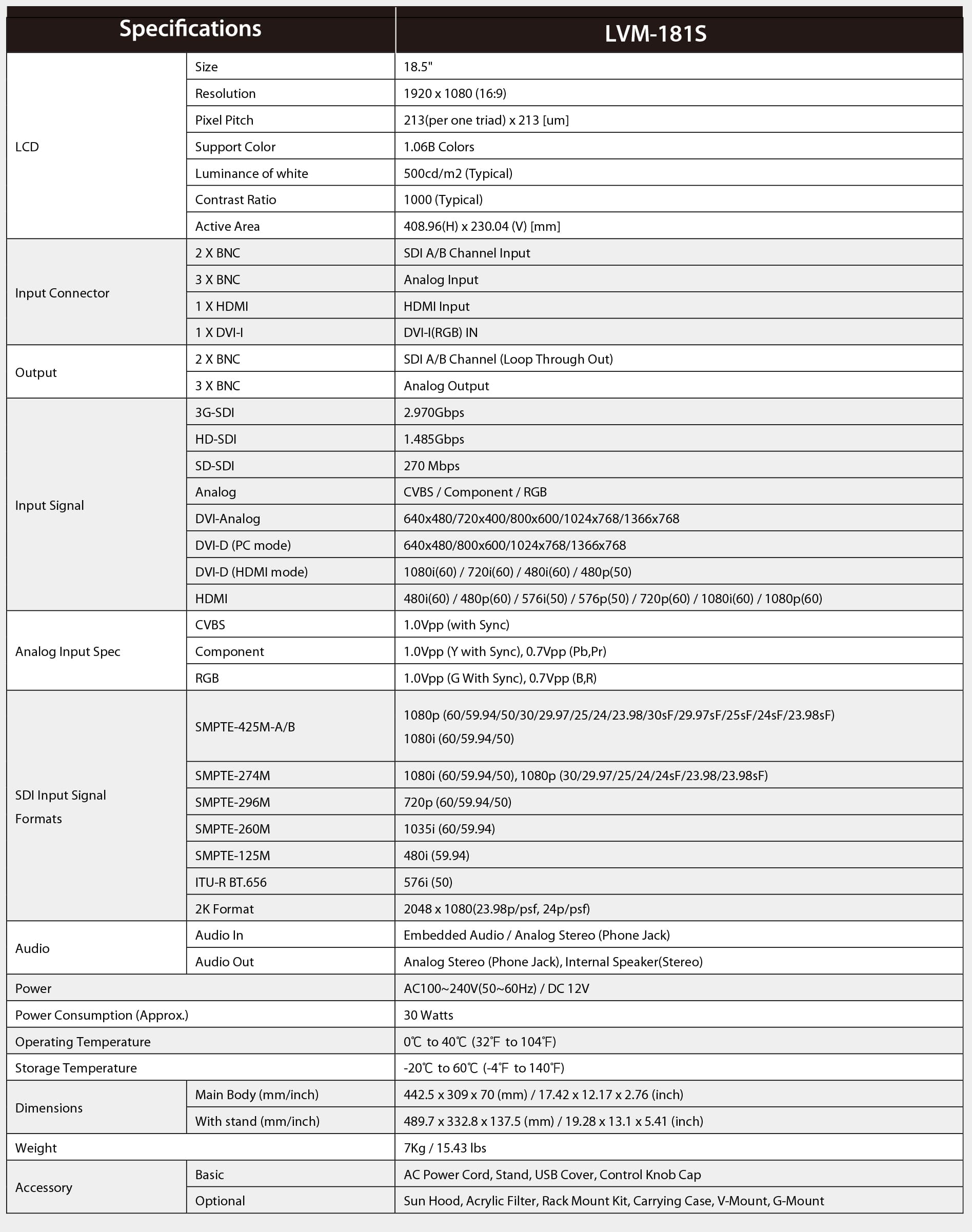LVM-181S : 18.5’’ FHD High-End LCD Monitor
The LVM-181S is our top grade 18.5” model with a 18.5 inch IPS LCD panel with 1920x1080 native resolution, high brightness 500 nit, enhanced contrast ratio and wide viewing angle all unmatched by other LCD monitors. A completely redesigned video processing unit provides powerful dual-channel performance and artifact-free image reproduction. Support for various cinema camera log-to-linear LUTs, easy field upgradability and a full array of image processing features are standard.







※ Image courtesy of LAWO group.



























18.5” FHD High-End LCD Monitor
The LVM-181S is our top grade 18.5” model with a 18.5 inch IPS LCD panel with 1920x1080 native resolution, high brightness 500 nit, enhanced contrast ratio and wide viewing angle all unmatched by other LCD monitors. A completely redesigned video processing unit provides powerful dual-channel performance and artifact-free image reproduction.
Support for various cinema camera log-to-linear LUTs, easy field upgradability and a full array of image processing features are standard.

Main Body Dimensions
Main Body 442.5 x 309 x 70 (mm) / 17.42 x 12.16 x 2.75 (inch)
With Body 489.7 x 332.8 x 137.5 (mm) / 19.27 x 13.1 x 5.41 (inch)
Weight 7kg / 15.43lbs
Product Highlights
• 18.5” Full HD Resolution (1920 x 1080)
• HDR (PQ, HLG, SLOG3)
• PBP (Picture by Picture)
• Custom 3D LUT Import by USB Flash Drive
• Various Built-in Camera LUTs
• Ember + Protocol support
• Fast Mode
• Waveform / Vectorscope (Advanced)
• 16ch Audio Level Meter
• Timecode Display
• Dual Markers (Main & Sub)
• Dynamic UMD
• H/V Delay
• User Aspect
• Various Scan Modes
• Closed Caption (CC-608/708, CC-KOR, OP47)
• Focus Assist
Optional Accessories
HDR Emulation
A true HDR monitor must employ a special display panel with high dynamic range and a wide color gamut, along with being calibrated for PQ and HLG. For example, the LUM-310X (dual layer LCD system) and LUM-310R (LCD with local dimming backlight system) are capable of reproducing a peak luminance of 1,000 nit and 2,000 nit respectively, and a contrast ratio of 1,000,000 : 1; in addition, they cover 99% of the DCI color gamut.


Other monitor utilizing displays with normal luminace range from 0.1nit up to 400nit or high luminance monitor with up to 2000nit with variable black level (0.1 ~ 1.5nit) is defined as 'HDR Emulation monitor' in TVLogic although they have HDR EOTF and related functions. Below is a simple example for your reference.
* True HDR Monitor : HDR Display (~1000nit, 1M CR, DCI gamut) + HDR EOTF & other related function
* HDR Emulation Monitor : Normal Display (~400nit, 1000:1, BT.709 gamut) + HDR EOTF & other related function
And in TVLogic monitors, HDR Emulation function includes the control parameters below;
* Standard Color Mode (HLG, PQ, PQ2)
* Video Range
* Display Luminance *
* HDR EOTF (PQ, HLG) or Camera Logs** (coming soon)
* PQ EETF (On / Off)
* HLG System Gamma (Fixed 1.2 / Auto)
* Color Gamut (BT.709, DCI-P3, BT.2020 and Native mode)
* White Point (D65, D93, DCI)
* Gamut Warning
* Shadow Mode *** (LUM-318G only)
* True HDR Monitor : HDR Display (~1000nit, 1M CR, DCI gamut) + HDR EOTF & other related function
* HDR Emulation Monitor : Normal Display (~400nit, 1000:1, BT.709 gamut) + HDR EOTF & other related function
And in TVLogic monitors, HDR Emulation function includes the control parameters below;
* Standard Color Mode (HLG, PQ, PQ2)
* Video Range
* Display Luminance *
* HDR EOTF (PQ, HLG) or Camera Logs** (coming soon)
* PQ EETF (On / Off)
* HLG System Gamma (Fixed 1.2 / Auto)
* Color Gamut (BT.709, DCI-P3, BT.2020 and Native mode)
* White Point (D65, D93, DCI)
* Gamut Warning
* Shadow Mode *** (LUM-318G only)
Ember+ control protocol
'Ember+' from LAWO group is a non-proprietary TCP/IP interface protocol for broadcast equipment. An Ember+ provider can "publish" parameters which may then be used by an Ember+ consumer. Please visit GITHUB site for more information.

※ Image courtesy of LAWO group.
1:1 Pixel Mapping Modes for SD/HD
Displays the original image resolution without scaling to match a certain resolution or an aspect ratio.
3G-SDI Level A/B
Supports 3G-SDI Level A/B input.
Audio Level Meter Display
Displays the level of the embedded sound signal together with the video signal input through the terminal such as SDI or HDMI.

Blue Only / Mono
Red and Green channels are not used and only Blue or Monochrome channel is used to display the screen. This function is used to adjust the color tones (tones and saturation) of the screen using the SMPTE Color Bar. For example, after displaying the Blue channel, adjust the Color (or Saturation) and Tint (or Hue) so that the original Magenta and Cyan are of the same brightness, and the original Gray and Blue are of the same brightness.

Custom 3D LUT Import
Allows you to load your making 3D-LUT files at NLE software like Davinci Resolve by USB flash memory and displays your LUT on VFM-055A or F-7H. Once you synchronize LUTs in the monitor, you will easily change them on production.

Closed caption
Closed caption.

Fast Mode
Fast Mode is to reduce the internal video processing time of the monitor to reduce the video latency and lip sync., usually by sacrificing the de-interlacing quality in the scaler IC.
Focus Assist
Assigns a color to the pixels on the boundaries of the image to inform the user to achieve the best focus. With this function, user can easily differentiate the focused area from out-focused area especially when shooting with a shallow depth of field.


H/V Delay
Allows you to check the Blanking area and synchronize signals by displaying the horizontal and vertical intervals in the center of the screen.

Key Lock
Key Lock is a password-protection function of the OSD menu so that non-authorized users cannot change the setting of the monitor.

Marker
Displays various kinds of aspect ratios on the screen. Wide range of markers and security areas are available with line color and curtain transparency selection. A User Marker is available if any of standard markers fits your requirements.

PBP(Picture by Picture)
Support displaying multiple inputs on the screen at the same time.



Range Error
Analyzes the input signal’s Luma (Y’) and chroma (C’) information. If the input signal exceeds the designated minimum and maximum values, the pixel will blink. This function allows for the user to easily identify any issues with exposure.


Time Code Display
Displays the Timecode information on the screen.

UMD
Displays user customized 8 characters or source ID or Tally signal of Ancillary (ANC) data on the screen.

User Aspect
Adjusts the Width /Height display ratio.



Various Scan Modes
Controls the size of the image. Overscan: Extra area around the four edges of the image that may not be seen reliably by the viewer. Underscan: Constrains the size of the image so the monitor shows everything the camera is seeing. 1:1 pixel: Displays the original image resolution without scaling to match a certain resolution or an aspect ratio.



Waveform/Vector Scope
Waveform Y: Displays the Luma(Y’), Cb, Cr component of the input signal into waveform.
Vector Scope: Displays the color components ‘B-Y’ and ‘R-Y’of the input signals onto the X-Y axis.
Vector Scope: Displays the color components ‘B-Y’ and ‘R-Y’of the input signals onto the X-Y axis.











